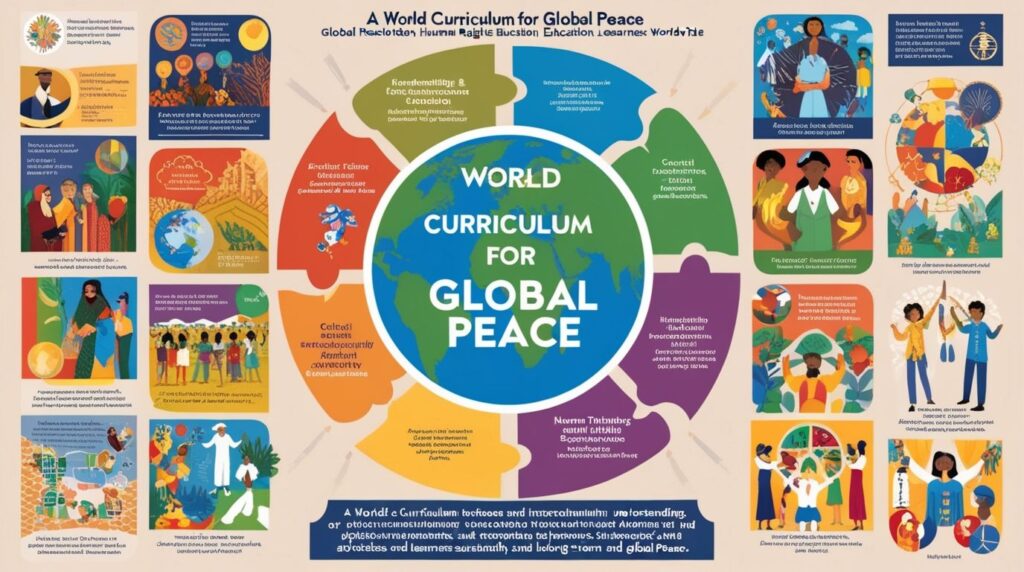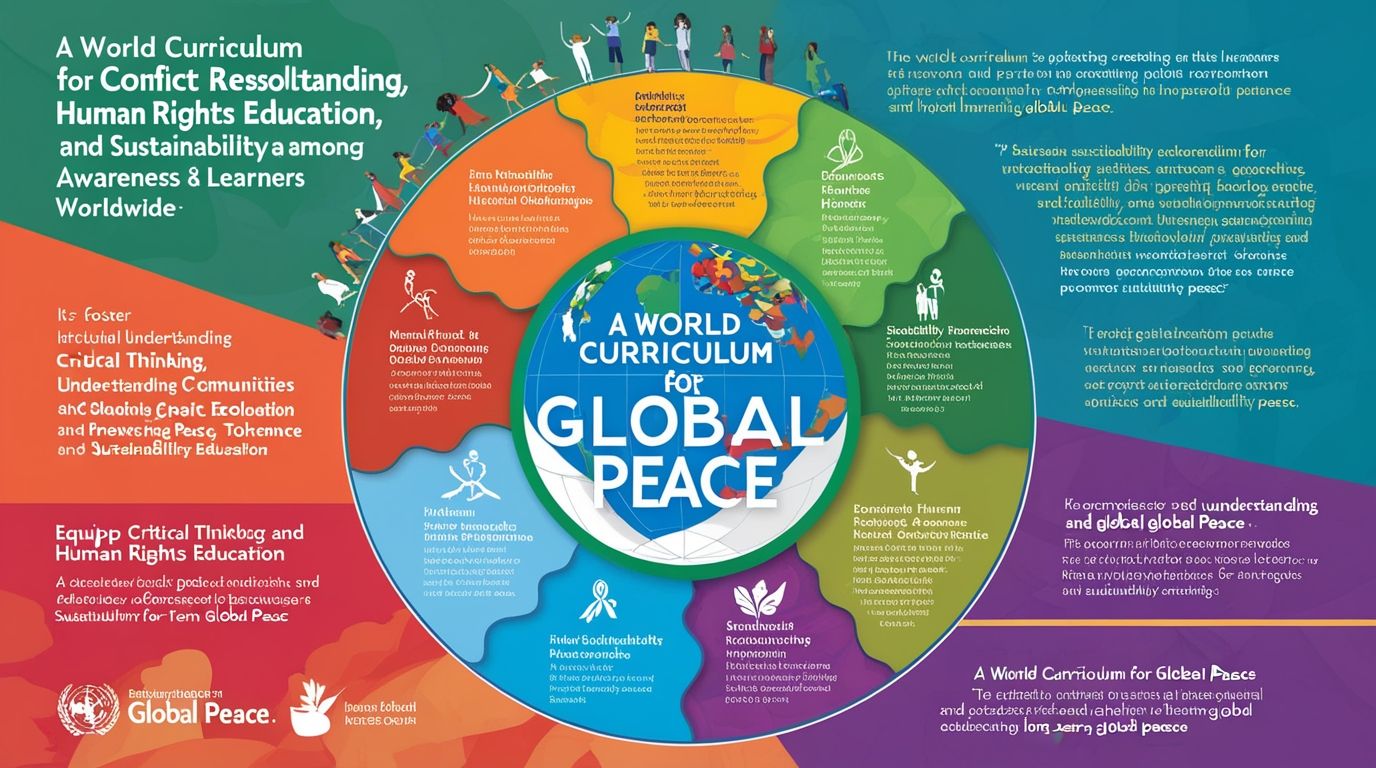Introduction
World Curriculum for Global Peace, In an increasingly interconnected world, the need for global peace has never been more pressing. As nations grapple with conflicts, economic disparities, and environmental crises, it is imperative to foster a culture of peace through education. A world curriculum for global peace aims to equip individuals with the knowledge, skills, and attitudes necessary to promote understanding, cooperation, and solidarity among diverse cultures and communities. This article explores the components of such a curriculum, its implementation strategies, and its potential impact on fostering global peace.
The Concept of a World Curriculum for Global Peace
A world curriculum for global peace encompasses educational frameworks designed to nurture peacebuilding skills, critical thinking, empathy, and cultural awareness among learners. It transcends traditional educational boundaries by integrating perspectives from various cultures, religions, and philosophies. The curriculum aims to instill a sense of global citizenship, encouraging individuals to recognize their role in creating a peaceful world.
Core Components of the Curriculum
- Intercultural UnderstandingThe curriculum must emphasize the importance of understanding and respecting different cultures. This includes:
- Cultural Studies: Courses that explore the history, values, and traditions of various societies can help students appreciate diversity.
- Language Learning: Proficiency in multiple languages fosters communication and empathy, bridging gaps between different communities.
- Conflict Resolution SkillsTeaching students how to address and resolve conflicts peacefully is essential. This includes:
- Negotiation and Mediation: Training in negotiation techniques and mediation skills prepares students to handle disputes constructively.
- Restorative Justice: Incorporating restorative practices encourages a shift from punitive approaches to healing and reconciliation.
- Human Rights EducationA strong foundation in human rights principles is vital for nurturing advocates of peace. This component includes:
- Understanding Rights and Responsibilities: Educating students about their rights and the rights of others fosters a culture of respect and responsibility.
- Global Citizenship: Courses on global citizenship highlight the interconnectedness of all individuals, promoting a sense of responsibility toward the global community.
- Sustainable Development and Environmental EducationPeace is closely tied to environmental sustainability. The curriculum should include:
- Ecological Awareness: Teaching students about environmental issues and sustainability fosters a sense of stewardship for the planet.
- Social Justice: Understanding the links between environmental degradation, poverty, and conflict is crucial for developing holistic solutions to global challenges.
- Critical Thinking and Media LiteracyIn a world rife with misinformation and propaganda, cultivating critical thinking skills is essential. This includes:
- Analyzing Information Sources: Teaching students how to discern credible information from biased or false narratives empowers them to make informed decisions.
- Promoting Dialogue: Encouraging respectful dialogue around controversial topics helps students navigate complex issues with empathy and understanding.

Implementation Strategies
Implementing a world curriculum for global peace requires a multi-faceted approach involving various stakeholders:
- Collaboration with Educators and Institutions
- Curriculum Development: Educators, scholars, and peace organizations should collaborate to design and implement curricula that reflect diverse perspectives and promote peace.
- Professional Development: Training programs for teachers can equip them with the tools and strategies needed to effectively teach peace education.
- Engaging Communities
- Community Involvement: Engaging local communities in the educational process ensures that curricula are relevant and culturally sensitive.
- Partnerships with NGOs: Collaborating with non-governmental organizations can provide additional resources and expertise in peacebuilding initiatives.
- Leveraging Technology
- Online Learning Platforms: Utilizing technology can facilitate access to peace education resources and connect students from different backgrounds.
- Social Media for Advocacy: Encouraging students to use social media for positive advocacy can amplify their voices and promote peace initiatives.
- Policy Support
- Government Initiatives: Governments should prioritize peace education in national curricula and allocate resources to support its implementation.
- International Cooperation: Collaborating with international organizations can facilitate the sharing of best practices and resources for peace education.
Potential Impact on Global Peace
The implementation of a world curriculum for global peace has the potential to create a ripple effect across communities and nations:
- Fostering Tolerance and RespectBy instilling values of tolerance and respect, the curriculum can help reduce prejudices and stereotypes, fostering a more inclusive society.
- Empowering Youth as Change AgentsEducating young people about peacebuilding equips them with the tools to become advocates for change in their communities and beyond.
- Reducing Violence and ConflictA curriculum focused on conflict resolution and mediation skills can contribute to the reduction of violence and the promotion of peaceful coexistence.
- Building Resilient CommunitiesBy promoting dialogue and understanding, communities can become more resilient in the face of challenges, leading to sustainable peace.
Conclusion
In conclusion, a world curriculum for global peace is not merely an educational initiative; it is a necessity for a harmonious future. By emphasizing intercultural understanding, conflict resolution skills, human rights education, sustainability, and critical thinking, we can empower individuals to become advocates for peace. The implementation of such a curriculum requires collaboration among educators, communities, and policymakers to create a comprehensive framework that addresses the complexities of our global society. As we move forward, fostering a culture of peace through education will be crucial in shaping a world where harmony and understanding prevail.
References
- UNESCO. (2015). “Global Citizenship Education: Preparing Learners for the Challenges of the 21st Century.” UNESCO.
- Galtung, J. (1996). “Peace by Peaceful Means: Peace and Conflict, Development and Civilization.” SAGE Publications.
- United Nations. (2016). “Transforming our World: The 2030 Agenda for Sustainable Development.” United Nations.
- McKown, M. (2017). “Teaching for Global Citizenship: A Guide for Educators.” Routledge.

9 thoughts on “World Curriculum for Global Peace”
Comments are closed.